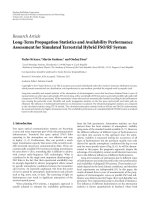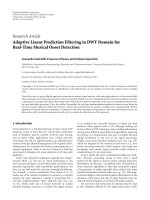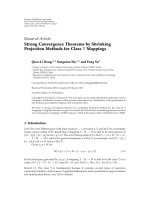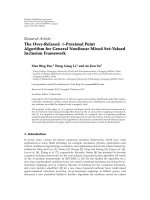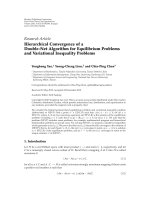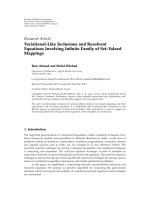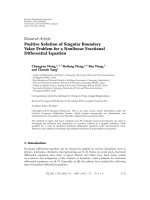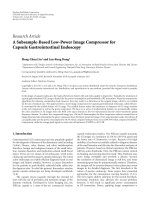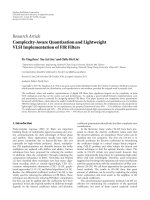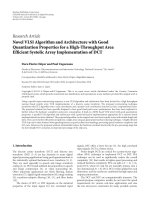Báo cáo hóa học: " Research Article Long-Term Propagation Statistics and Availability Performance Assessment for Simulated Terrestrial Hybrid FSO/RF System" pdf
Bạn đang xem bản rút gọn của tài liệu. Xem và tải ngay bản đầy đủ của tài liệu tại đây (1.42 MB, 9 trang )
Hindawi Publishing Corporation
EURASIP Journal on Wireless Communications and Networking
Volume 2011, Article ID 435262, 9 pages
doi:10.1155/2011/435262
Research Ar ticle
Long-Ter m Propagation Stat i stics and Availability Performance
Assessment for Simulated Terrestrial Hybrid FSO/RF System
Vaclav Kv icera,
1
Martin Grabner,
1
and Ondrej Fiser
2
1
Czech Metrology Institute, Hvozdanska 3, 148 00 Prague 4, Czech Republic
2
Institute of Atmospheric Physics, The Academy of Sciences of the Czech Republic, Bocni II/1401, 141 31 Prague 4, Czech Republic
Correspondence should be addressed to Vaclav Kvicera,
Received 1 November 2010; Accepted 7 February 2011
Academic Editor: Fabrizio Granelli
Copyright © 2011 Vaclav Kvicera et al. This is an open access article distributed under the Creative Commons Attribution License,
which permits unrestricted use, distribution, and reproduction in any medium, provided the original work is properly cited.
Long-term monthly and annual statistics of the attenuation of electromagnetic waves that have been obtained from 6 years of
measurements on a free space optical path, 853 meters long, with a wavelength of 850 nm and on a precisely parallel radio path with
a frequency of 58 GHz are presented. All the attenuation events observed are systematically classified according to the hydrometeor
type causing the particular event. Monthly and yearly propagation statistics on the free space optical path and radio path are
obtained. The influence of individual hydrometeors on attenuation is analysed. The obtained propagation statistics are compared
to the calculated statistics using ITU-R models. The calculated attenuation statistics both at 850 nm and 58 GHz underestimate
the measured statistics for higher attenuation levels. The availability performance of a simulated hybrid FSO/RF system is analysed
based on the measured data.
1. Introduction
Free space optical communication systems are becoming
a more and more important part of the telecommunication
infrastructure. Terrestrial free space optical (FSO) links
operating in the atmosphere are cost effective and easy
to deploy [1, 2]. Furthermore, they can provide a much
larger transmission capacity than most of the currently avail-
able terrestrial microwave communication links. There are
commercially-available FSO systems providing transmission
bit rates above 1 Gb/s, something that is difficult to achieve
with current radio-frequency (RF) technologies. What is
considered to be the single most important disadvantage of
FSO links is the fact that their operational availability may
be strongly degraded by adverse propagation effects caused
by specific atmospheric conditions between the transmitter
and receiver. An especially unpleasant role from this point
of view is played by atmospheric hydrometeors and aerosols
such as fog, snow, rain, or dust. The scattering of light on
hydrometeors may result in significant attenuation of the
received optical power.
When planning FSO systems, a pragmatic approach is
usually adopted to estimate the availability performance
from the link parameters. Attenuation statistics are then
derived from the local statistics of atmospheric visibility
using some of the standard models available [3–7]. However,
the different influence of different types of hydrometeors is
not taken into account in this approach since the atmo-
spheric visibility is measured during the occurrence of all
types of hydrometeors but the pertinent models were only
derived for specific atmospheric conditions like fog or even
only for more specific types of fog [5, 6]. As will be demon-
strated in this paper, the pragmatic approach, despite the
advantage of its simplicity, cannot avoid inherent inaccuracy
due to the different influences of different hydrometeors.
Long-term statistics of attenuation due to different types
of hydrometeors are needed to predict the error performance
and availability of designed FSO systems. These statistics cer-
tainly depend on the local climatic conditions, and therefore
local experiments are indispensable [8]. In this paper, the
results obtained from 6 years of measurements of the prop-
agation of electromagnetic waves on parallel FSO and mil-
limetre wave links located in Prague (the Czech Republic) are
presented. The experimental setup is described in Section 2.
The influence of different hydrometeors on the attenuation
statistics is shown quantitatively in Section 3 where both
2 EURASIP Journal on Wireless Communications and Networking
the FSO and RF systems operating on exactly the same
path are compared. In Section 4, the obtained statistics are
compared with the predicted statistics calculated from mea-
sured atmospheric parameters such as atmospheric visibility
and the rain rate using estimation methods recommended
by ITU-R. Finally, the potential performance improvement
of hybrid FSO/RF systems utilizing frequency diversity is
analyzed in Section 5.
2. Experimental Setup
Two experimental parallel FSO/RF paths are operated in
a collaboration of the Czech Metrology Institute (CMI) with
the Institute of Atmospheric Physics of the Academy of
Sciences of the Czech Republic (IAP AS CR). Both of their
path lengths are about 853 meters.
The FSO link is working at 850 nm. The transmitted
power is about 16 dBm, the divergence angle is 9 mrad,
and the optical receiver’s aperture is 515 cm
2
. The recording
optical fade margin is about 18 dB. The RF link is working
at 57.650 GHz with vertical polarisation. The transmitted
power is about 5dBm and the recording fade margin is about
27 dB. The experimental setup situated on the roofs of both
the buildings of the CMI and the IAP AS CR can be seen in
Figure 1.
The terrain profile between the end sites of the path is
line-of-sight. The elevation angle from IAP AS CR to CMI is
about 2.2
◦
, and the altitude difference is about 33 m.
An automatic weather observation system and colour
video-camera images of the space between the transmitter
and the receiver sites are used for the identification of mete-
orological conditions. The system uses Vaisala sensors for
the measurement of temperature, humidity, air pressure, and
the velocity and direction of the wind. The rain intensities
are measured using a dynamically-calibrated heated tipping-
bucket rain gauge with a collector area of 500 cm
2
,andthe
rain amount per tip is 0.1 mm. The Vaisala PWD11 device
is used for the measurement of visibility in the range from
2000 m up to 50 m. The meteorological data is synchronised
in time with the hydrometeor attenuation measurement on
both the FSO and RF links. Both the received FSO and
RF signal levels and the meteorological data are recorded
synchronously on a computer hard disk.
3. Experimental Results
The obtained attenuation time series data was processed
over a 6-year period from December 2003 to November
2009. All the recorded individual attenuation events on both
the FSO and RF links were compared with the concurrent
meteorological conditions. Only those attenuation events
which were unambiguously identified due to their origin
were further carefully categorized according to the types
of hydrometeors that occurred. Attenuation events were
categorized into the following types according to their origin:
rain (R), a mixture of rain with snow (RS), a mixture of rain
with hail (RH), snow (S), fog only (F), a mixture of fog with
rain (FR), a mixture of fog with snow (FS), and a mixture of
fog with rain and snow (FRS). This categorized attenuation
time series data was statistically processed and the cumulative
distributions (CDs) of attenuation due to hydrometeors
describing the probability in percentages of time in the
year of having an instantaneous level of attenuation A (dB)
greater than the chosen value a (dB), that is, P(A
≥ a)as
given in [9] were obtained for the individual months and
the individual year periods over the 6-year data-gathering
period.
3.1. Monthly CDs of Attenuation due to Hydrometeors on FSO
and RF Paths. The obtained monthly CDs of attenuation due
to all the hydrometeors combined (i.e., due to R, RS, S, F, FR,
FS, and FRS together) over the 6-year period of observation
on the FSO and RF paths are given in Figures 2 and 3.
The large month-to-month variability of these distri-
butions for both the FSO and RF paths can be observed
in both Figures. On the FSO path, significant attenuation
events greater than 15 dB occurred in November, October,
December, February, and January. The attenuation events in
the other months were not significant because they occurred
forashorttime(theirCDsareshiftedbymorethanone
decade to smaller percentages of time). On the RF path, the
significant attenuation events greater than 15 dB occurred in
March and October. It can be observed that the significant
attenuation events on the FSO path occurred in the decade
betweenthe1and10percentageoftimewhilethesignificant
attenuation events on the RF path occurred in one decade
lower, that is, between the 0.1 and 1 percentages of time.
3.2. Yearly CDs of Attenuation due to Hydrometeors on FSO
and RF Paths. The obtained CDs of attenuation due to all
the hydrometeors combined on the FSO and RF paths for
the individual year periods are shown in Figures 4 and 5.
It can be seen that the dominant attenuation events
occurred on the FSO path during the 5th year of observation
while the dominant attenuation events on the RF path
occurred during the 4th year period. Greater year-to-year
variability of the CDs of attenuation due to all the hydrom-
eters combined can be observed on the RF path. It can be
stated that the significant attenuation events on the FSO path
occurred for the percentages of time smaller than 3% while
the significant attenuation events on the RF path occurred
for the percentages of time smaller than 0.3%.
3.3. CDs of Attenuation due to Individual H ydrometeors on
FSO and RF Paths. Figure 6 shows the obtained CDs of
attenuation due to all the hydrometeors combined and to the
individual hydrometeors separately on the FSO path over the
6-year period of observation.
The solid line in Figure 6 corresponds to the CD of
attenuation due to all the hydrometeors combined over the
entire 6-year period of observation, and it may be considered
as the long-term average annual distribution of attenuation
due to all the hydrometeors combined in the sense of [10, 11].
It follows from Figure 6 that the dominant attenuation events
were caused by all fog events together, that is, by F, FR, FS,
and FRS events.
EURASIP Journal on Wireless Communications and Networking 3
Video
camera
RF
58 GHz
FSO
850 nm
(a)
RF
58 GHz
FSO
850 nm
(b)
Figure 1: FSO system, RF system, and video camera at CMI (a); FSO system and RF system at IAP AS CR (b).
0
5
10
15
20
A (dB)
0.01 0.1 1 10 100
Time (%)
Dec
Jan
Feb
Mar
Apr
May
Jun
Jul
Aug
Sep
Oct
Nov
Figure 2: Obtained monthly CDs of attenuation due to all the
hydrometeors combined on the FSO path over the 6-year period.
The impact of individual fog events can be seen in
Figure 7.
It can be seen that the fog with rain attenuation events
were dominant events and the fog only events and the fog
with snow events were also significant contributors to the
overall attenuation on the FSO path. The fog with rain
and snow events were insignificant due to the fact that
these events occurred for shorter periods, and therefore their
CDs are shifted about one decade or more to the smaller
percentages of time against the CD of attenuation due to fog
with rain events.
0
5
10
15
20
25
30
A (dB)
0.00001 0.0001 0.001 0.01 0.11 10
Time (%)
Dec
Jan
Feb
Mar
Apr
May
Jun
Jul
Aug
Sep
Oct
Nov
Figure 3: Obtained monthly CDs of attenuation due to all the
hydrometeors combined on the RF path over the 6-year period.
The obtained CDs of the average 1-minute rain intensi-
ties (R(1)) for both all the hydrometeors combined and the
individual hydrometeors are shown in Figure 8. It can be seen
that the maximum value of R(1) for FR events was about
13.6 mm/h. According to [12], this rain intensity can cause
attenuation of about 6 dB/km that contributes to part of the
fog attenuation during the FR events. The R(1) obtained
forRS,RH,S,FS,andFRSeventsdonotcorrespondto
reality because, in most cases, it is dependent on the rate
by which the snow accumulated in the heated rain gauge’s
collector melts. Therefore, the obtained R(1) values for these
4 EURASIP Journal on Wireless Communications and Networking
0
5
10
15
20
A (dB)
0.1 1 10 100
Time (%)
1st year period
2nd year period
3rd year period
4th year period
5th year period
6th year period
Figure 4: Obtained yearly CDs of attenuation due to all the
hydrometeors combined on the FSO path for the individual year
periods.
0
5
10
15
20
25
30
A (dB)
0.00001 0.0001 0.001 0.01 0.1 1 10 100
Time (%)
1st year period
2nd year period
3rd year period
4th year period
5th year period
6th year period
Figure 5: Obtained yearly CDs of attenuation due to all the
hydrometeors combined on the RF path for the individual year
periods.
events are only informative and cannot be used for precise
calculations of attenuation due to these events.
It should be noted that very small differences can be
seen between the CD of R(1) due to all the hydrometeors
combined and the CD of R(1) due to rain only. The
maximum difference is about 5 mm/h for 0.00045% of the
time. This is due to the fact that the rain intensities occur for
significantly longer times then for the other events.
The obtained CDs of attenuation due to all the hydrom-
eteors combined and to the individual hydrometeors sepa-
rately on the RF path over the 6-year period of observation
are given in Figure 9.
ThesolidlineinFigure 9 corresponds to the CD of
attenuation due to all the hydrometeors combined over the
0
5
10
15
20
A (dB)
0.001 0.01 0.1 1 10 100
Time (%)
All
R
RS
S
F + FR + FS + FRS
Figure 6: Obtained CDs of attenuation due to all the hydrometeors
combined and the individual hydrometeors separately on the FSO
path over the 6-year period of observation.
0
5
10
15
20
A (dB)
0.0001 0.001 0.01 0.11 10
Time (%)
F + FR + FS + FRS
F
FR
FS
FRS
Figure 7: Obtained CDs of attenuation due to fog events on the
FSO path over the 6-year period of observation.
entire 6-year period of observation, and it may be considered
as the CD of attenuation due to all the hydrometeors
combined for the average year. It can be seen that the
dominant attenuation events were caused by rain with snow
events. Significant attenuation events were also caused by
snow-only events. However, it should be stressed that this
might be partly due to snow particles that, in some events,
settled down on the antenna radomes and caused additional
attenuation. Because it is not possible to recognize and to
exclude the portions of these additional attenuation events
caused by RS events and S events, attenuation due to rain
also has to be considered as significant. It can also be seen
that the influence of all the fog events on the total attenuation
is entirely insignificant.
EURASIP Journal on Wireless Communications and Networking 5
0
10
100
1000
R(1) (mm/h)
0.00001 0.0001 0.001 0.01 0.11 10
Time (%)
All
R
RS
RH
S
FS
FR
F
FRS
F + FR + FS + FRS
Figure 8: Obtained CDs of the average 1-minute rain intensities
for all the hydrometeors combined as well as for the individual
hydrometeors.
0
5
10
15
20
25
30
A (dB)
0.000001 0.00001 0.0001 0.001 0.01 0.11 10
Time (%)
All
R
RS
S
F + FR + FS + FRS
Figure 9: Obtained CDs of attenuation due to all the hydrometeors
combined and to the individual hydrometeors separately on the RF
path over the 6-year period of observation.
4. Comparison of Measured and C omputed
Attenuation Values
4.1. FSO Path. The availability performance of the FSO
link is seriously affected by lower atmospheric visibility.
Fog seems to be the most important impairment factor for
FSO links [13]. Our results, given in Figure 6,confirmthis
statement. Nevertheless, the influence of other hydrometeors
like rain, snow, and rain with snow as well as their combi-
nation with fog should also be taken into account because
they may significantly reduce the atmospheric visibility [14].
Visibility measurements are carried out routinely at many
meteorological stations and airports by means of trans-
missometers or diffusiometers. These measurements do not
0
500
1000
1500
2000
V (m
0.00001 0.0001 0.001 0.01 0.11 10
Time (%)
All
R
RS
S
All fogs
Figure 10: Obtained CDs of visibility due to all the hydrometeors
combined and to the individual hydrometeors separately on the
FSO path over the 6-year period of observation.
0
500
1000
1500
2000
V (m)
0.0001 0.001 0.01 0.11 10
Time (%)
All fogs
F
FS
FR
FRS
Figure 11: Obtained CDs of visibility due to all the fog events
combined and to the individual fog events separately on the FSO
path over the 6-year period of observation.
differentiate between fog-only events and the combinations
of fog with the other hydrometeors. However, this visibility
data is usually used for the conversion of visibility to fog
attenuation. Several common methods [3–7]canbeusedfor
the conversion.
The obtained CDs of visibility due to all the hydromete-
ors combined (denoted as all) and to the individual hydrom-
eteors separately on the FSO path over the 6-year period of
observation are shown in Figure 10.
It can be seen in Figure 10 that the visibility is signifi-
cantly reduced by all fog events. The influence of snow, rain
with snow, and rain is not significant, mainly for visibility
smaller than 1000 m.
6 EURASIP Journal on Wireless Communications and Networking
5
10
15
20
A (dB)
0.11 10
Time (%)
All
Kruse
Kim
Al Naboulsi adv
Al Naboulsi conv
Ferdinandov
Figure 12: Comparison of the CDs of measured attenuation due
to all the hydrometeors combined with the calculated attenuation
from visibility data based on the measured visibility distribution.
The obtained CD of attenuation due to all of the fog
events, which is shown in Figure 10,iscomposedoftheCDs
of attenuation due to fog only, fog with snow, fog with rain,
and fog with rain and snow. It can be seen in Figure 11.
It follows from Figure 11 that both fog with rain events
and fog-only events have a significant impact on visibility,
while fog with snow events and fog with rain and snow
events are insignificant due to their occurrence for only small
percentages of time, and therefore they cannot significantly
contribute to the CD of attenuation due to all the events
combined.
The obtained CDs of visibility due to all the hydromete-
ors combined (denoted as “all” in Figure 10)wereusedfor
the calculation of attenuation due to all the hydrometeors
combined by common methods, that is, the Kruse method,
the Kim method, the Al Naboulsi method for advection
fog, the Al Naboulsi method for convection fog, and the
Ferdinandov method [3–7]. The Kruse method is the recom-
mended one in [12]. The results obtained are compared with
the obtained CD of attenuation due to all the fog events in
Figure 12.
It can be seen that both of the Al Naboulsi methods
better fit the measured distribution then the Kruse, Kim, and
Ferdinandov methods. As mentioned above in Section 4.1,
the measurement of visibility at meteorological stations and
airports do not differentiate among lower visibility due to
fog-only events, due to individual hydrometeors, and due to
all the hydrometeors combined. In spite of this, it follows
from Figure 12 that this visibility data can be used for
attenuation calculations by common methods.
The obtained CD of visibility due to fog-only events,
denoted in Figure 11 as F, was also used for the calculation of
attenuation due to fog only by the aforementioned methods.
The results obtained are compared with the obtained CD of
attenuation due to fog only in Figure 13.
It is seen that the differences of attenuation values among
the calculated distributions and the measured distribution
5
10
15
20
A (dB)
0.11
Time (%)
F
Kruse
Kim
Al Naboulsi adv
Al Naboulsi conv
Ferdinandov
Figure 13: Comparison of the calculated CDs of attenuation due to
fog only from visibility data with the measured distribution.
0
5
10
15
20
25
30
A (dB)
0.0001 0.001 0.01 0.11 10
Time (%)
Measured
Calculated, R(1)
= 28.4mm/h
Calculated, R(1)
= 31.8mm/h
Calculated, R(1)
= 35.2mm/h
Figure 14: Comparison of obtained CD of attenuation due to rain
and calculated CDs of attenuation due to rain.
are greater than in the previous case. Again, both of the Al
Naboulsi methods fit slightly better than the others.
Due to the fact that Figures 12 and 13 can be used for the
assessment of the availability performance of the FSO link,
the agreement between the calculated CD of attenuation and
the measured one should be evaluated in the direction of
thepercentageoftimeaxis,notindifferences between the
calculated attenuation values and the measured ones. From
this point of view, the agreement between the calculated and
the measured percentages of time is surprisingly good for the
attenuation values from 7 dB to 17 dB.
4.2. RF Path. The obtained CD of the average 1-minute
rain intensities R(1), given in Figure 8,canbeusedfor
the calculation of the CD of attenuation due to rain in
accordance with the relevant ITU-R Recommendation [10].
The method can only be used for percentages of time in
EURASIP Journal on Wireless Communications and Networking 7
0
5
10
15
20
25
30
A (dB)
0.00001 0.0001 0.001 0.01 0.1 1 10 100
Time (%)
FSO
RF
Hybrid
Figure 15: Obtained CDs of attenuation due to all the hydrom-
eteors combined for the FSO link, RF link, and simulated hybrid
FSO/RF system.
1
10
100
1000
IA (−)
0 5 10 15 20
A (dB)
Figure 16: Obtained diversity improvement factor.
the range from 0.001% to 1%. Three different R(1)
0.01
values
were used for the calculations: (a) R(1)
0.01
= 28.4 mm/h
obtained from the measured R(1) at CMI over the 6-year
period and given in Figure 8,(b)R(1)
0.01
= 31.8 mm/h
obtained from rain intensity data processing over a 50-year
period at a site with average meteorological conditions in the
Czech Republic [15, 16], and (c) R(1)
0.01
= 35.2 mm/h given
in [17]. The results obtained are given in Figure 14.
It can be seen that the measured values of attenuation due
to rain are always greater than the calculated ones, especially
for the percentages of time smaller than 0.1%. It might
be due to the fact that the ITU-R prediction procedure is
considered to be valid for frequencies up to at least 40 GHz
and for path lengths up to 60 km, and the minimum path
length is not specified.
0
5
10
15
G(A)(dB)
0.11 10
Time (%)
Figure 17: Obtained diversity gain.
5. Availabilit y Performance of Hybrid
Terrestr ial FSO/RF System
The availability performances of both FSO links and RF
links significantly depend on meteorological conditions. Low
atmospheric visibility causes the deep attenuation of optical
light on the FSO links while heavy rain events, snow events,
and rain with snow events cause deep attenuation on the
RF links. Therefore, fog events have a significant impact on
the availability performance of FSO links while rain events
have a significant impact on the availability performance
of RF links. The concurrent occurrence of dense fog events
and heavy rain events are seldom. Therefore, hybrid FSO/RF
systems which consist of an FSO link backed up by an RF
link can achieve higher link availability performance than a
separate FSO or RF link due to the fact that the RF part of
hybrid FSO/RF system may mitigate the influence of dense
fog events and the FSO part can mitigate heavy rain events
[18, 19].
The availability performance of the transmission link can
be assessed from the cumulative distribution of attenuation
due to all hydrometeors together for the known value of
the fade margin. A hybrid FSO/RF system was simulated by
a simple diversity—technique-instantaneous values of both
the FSO and RF path attenuation were compared and the
better signal was chosen as the receiving signal. The obtained
CDs of attenuation due to all the hydrometeors combined for
the FSO link, the RF link, and the simulated hybrid FSO/RF,
system over the entire 6-year period of observation are shown
in Figure 15.
The assessed availability performances (AP) of the FSO
link, the RF link, and the simulated hybrid FSO/RF system
which have the same fade margin FM
= 17 dB are given in
Ta b l e 1.
It can be seen from Ta b le 1 that a significant improve-
ment of both the availability performance and the out-
age time, practically two orders of magnitude (nearly 76
hours/year), could be achieved for the simulated hybrid
FSO/RF system in comparison with the FSO system alone.
The improvement of the availability performances of
the hybrid FSO/RF system can be assessed by diversity
8 EURASIP Journal on Wireless Communications and Networking
Table 1: Availability performances of FSO, RF, and simulated
hybrid FSO/RF system.
System
AP (%) AP (hours/year) Outage time
FSO
99.1340 8684.14 75.86 hours/year
RF
99.9547 8756.03 3.97 hours/year
Hybrid
FSO/RF
99.9989 8759.90 5.78 minutes/year
characteristics. The improvement due to the hybrid FSO/RF
system used can be expressed as the diversity improvement
factor I(A)orthediversitygainG(A), which are defined in
[10, 20], in the following manner:
I
(
A
)
=
P
FSO
(
A
)
P
d
(
A
)
,
P
d
(
A
)
= min
(
P
FSO
(
A
)
, P
RF
(
A
))
,
G
(
A
)
= A
FSO
(
t
)
−A
d
(
t
)
,
A
d
(
t
)
= min
(
A
FSO
(
t
)
, A
RF
(
t
))
,
(1)
where P
d
(A) is the percentage of time in the combined diver-
sity path with a fade depth larger than A, P
FSO
(A)isthe
time percentage for the FSO path, and P
RF
(A)isthetime
percentage for the RF path. Similarly, A
d
(t)isthefade
depth in the combined diversity path occurring in the time
percentage t, A
FSO
(t) is the fade depth for the FSO path and
A
RF
(t) is the fade depth for the RF path.
The diversity improvement factor I(A)andthediversity
gain G(A) for the entire 6-year period of observation are
given in Figures 16 and 17.
It follows from Figure 16 that the higher the attenuation
on the path, the higher the diversity improvement factor for
the hybrid FSO/RF system that can be achieved. The diversity
improvement factor I(A) reaches significant values greater
than 10 for attenuation events greater than 5 dB.
It can be seen in Figure 17 that a significant diversity gain
greaterthan5dBcanbeachievedforthehybridFSO/RF
system for the percentages of time smaller than 2%.
A simple hard-switching [21] described in Section 5 was
considered for the simulated hybrid FSO/RF system. Soft
switching may furthermore improve the availability perfor-
mance of the hybrid FSO/RF system [22].
6. Conclusion
Attenuation events were systematically classified in order to
quantitatively demonstrate the impact of different types of
hydrometeors on both FSO and RF systems. It is confirmed
that in the climatic region of Central Europe, fog and com-
binations of fog with other hydrometeors seriously degrade
the availability of FSO systems. On the other hand, rain and
snow are the most adverse effects limiting the availability of
the millimetre-wave RF systems. This suggests the possibility
of utilizing frequency/wavelength diversity.
The availability performance of a simulated hybrid ter-
restrial FSO/RF system was assessed. It is shown that a simple
hard-switching diversity system has the potential to reduce
the unavailability time fraction by about two orders of
magnitude with respect to the FSO system alone.
Probability distributions obtained from measured atten-
uation and distributions calculated using different models
were compared. Measured attenuation exceedance time per-
centages are larger than predicted for higher attenuation val-
ues. This may be caused by the inhomogeneous distribution
of a specific attenuation between the transmitter and receiver.
In our experiment, atmospheric visibility is measured locally
near the FSO receiver and thus does not describe the whole
propagation path well.
We are aware that the results obtained are strongly
climatically dependent. Local data is certainly needed for the
design of FSO systems in a particular location. As already
mentioned, atmospheric visibility is routinely measured at
airports. It gives an opportunity to obtain attenuation statis-
tics at nearby locations using the aforementioned models.
Even if local data is available, a path length scaling procedure
has to be considered in order to get realistic estimations of
attenuation statistics on links with different path lengths.
This problem also relates to possible inhomogeneous path
attenuation. For all that, the results obtained are of impor-
tance to the optical community, both to those deploying
FSO links in similar weather conditions as in Prague and
to all those designing FSO links, since they will have more
data about the availability performances of FSO links because
long-term propagation statistics of FSO systems are still very
scarce.
Despite recent progress, the modelling of attenuation
statistics on FSO paths is not yet fully developed compared
with RF systems. Further theoretical and experimental work
is appreciated in the area of the conversion models between
atmospheric parameters and optical attenuation as well as in
the area of path-length scaling.
Acknowledgments
This work was supported by the Czech Science Foundation
under Project no. 102/08/0851 and the Ministry of Educa-
tion, Youth and Sports of the Czech Republic under Project
no. OC09076 in the framework of COST Action IC0802.
References
[1] H. A. Willebrand and G. R. Clark, “Free space optics: available
last mile alternative,” in Wireless and Mobile Communications,
pp. 11–21, November 2001.
[2] O.Bouchet,H.Sizun,C.Boisrobert,F.deFornel,andP.Faven-
nec, Free-Space Optics, Propagation and Communication,ISTE,
London, UK, 2006.
[3] P. Kruse et al., Elements of Infrared Technology,JohnWiley&
Sons, New York, NY, USA, 1962.
[4]I.I.Kim,B.McArthur,andE.Korevaar,“Comparisonof
laser beam propagation at 785 nm and 1550nm in fog and
haze for optical wireless communications,” in Optical Wireless
Communications III, vol. 4214 of Proceedings of SPIE, pp. 26–
37, November 2000.
EURASIP Journal on Wireless Communications and Networking 9
[5] M. Al Naboulsi, H. Sizun, and F. De Fornel, “Fog attenuation
prediction for optical and infrared waves,” Optical Engineering,
vol. 43, no. 2, pp. 319–329, 2004.
[6] M. Al Naboulsi, H. Sizun, and F. de Fornel, “Fog attenuation
of a laser radiation in the 0.69 to 1.55 μmspectralregion,”
in Proceedings of European Conference on Wireless Technology
(ECWT ’03), October 2003.
[7] E. Ferdinandov, K. Dimitrov, A. Dandarov, and I. Bakalski, “A
general model of the atmosphere scattering in the wavelength
interval 300–1100 nm,” Radioengineering, vol. 18, no. 4, pp.
517–521, 2009.
[8] K. Wakamori, K. Kazaura, and I. Oka, “Experiment on
regional broadband network using free-space-optical commu-
nication systems,” Journal of Lightwave Technology, vol. 25, no.
11, pp. 3265–3273, 2007.
[9] Rec. ITU-R P.1057-2, “Probability distributions relevant to
radiowave propagation modelling,” ITU, Geneva, Switzerland,
2009.
[10] Rec. ITU-R P.530-12, “Propagation data and prediction
methods required for the design of terrestrial line-of-sight
systems,” ITU, Geneva, Switzerland, 2009.
[11] Rec. ITU-R P.841-4, “Conversion of annual statistics to worst-
month statistics,” ITU, Geneva, Switzerland, 2009.
[12] Rec. ITU-R P.1814, “Prediction methods required for the
design of terrestrial free-space optical links,” ITU, Geneva,
Switzerland, 2009.
[13] E.Korevaar,I.I.Kim,andB.McArthur,“Atmosphericprop-
agation characteristics of highest importance to commercial
free space optics,” in Atmospheric Propagation, vol. 4976 of
Proceedings of SPIE, pp. 1–12, April 2003.
[14] V. Kvicera, M. Grabner, and O. Fiser, “Visibility and attenu-
ation due to hydrometeors at 850 nm measured on an 850 m
path,” in Proceedings of the 6th International Symposium Com-
munication Systems, Networks and Digital Signal Processing,
(CSNDSP ’08), pp. 270–272, Graz, Austria, 2008.
[15] V. Kvicera, J. Kerhart, and P. Cejka, “Calculations of free
space attenuation and attenuation due to rain and hails at the
frequency bands from 10 to 63 GHz,” Tech. Rep. 1 33 800,
TESTCOM, Prague, Czech Republic, November 1996.
[16] W. Albrecht and J. Sander, “Zusammenhang zwischen kurz-
und langzeit-intensit
¨
at von regen als grundlage f
¨
ur die plan-
nung von richtfunkstrecken,” Frequenz, vol. 31, no. 11, pp.
341–343, 1977.
[17] Rec. P.837-5, “Characteristics of precipitation for propagation
modelling,” ITU, Geneva, Switzerland, 2009.
[18] F. Nadeem, E. Leitgeb, V. Kvicera, M. Grabner, M. S. Awan,
and G. Kandus, “Simulation and analysis of FSO/RF switch
over for different atmospheric effects,” in Proceedings of the
10th International Conference on Telecommunications (ConTEL
’09), pp. 39–43, Zagreb, Croatia, June 2009.
[19] E. Leitgeb, M. Gebhart, J. Birnbacher, W. Kogler, and P.
Schrotter, “High availability of hybrid wireless networks,” in
Reliability of Optical Fiber Components, Devices, Systems, and
Networks II, vol. 5465 of Proceedings of SPIE, pp. 238–249,
2004.
[20] Rec. ITU-R P.1410-3, “Propagation data and prediction
methods required for the design of terrestrial broadband
millimetric radio access systems operation in a frequency
range of about 20–50 GHz,” ITU, Geneva, Switzerland, 2006.
[21] A. Akbulut, H. G. Ilk, and F. Ari, “Design, availability
and reliability analysis on an experimental outdoor FSO/RF
communication system,” in Proceedings of the 7th I nternational
Conference on Transparent Optical Networks (ICTON ’05),pp.
403–406, July 2005.
[22] W. Zhang and S. Hranilovic, “Soft-switching hybrid FSO/RF
links using short-length raptor codes: design and implemen-
tation,” IEEE Journal on Selected Areas in Communications,vol.
27, no. 9, pp. 1–11, 2009.
